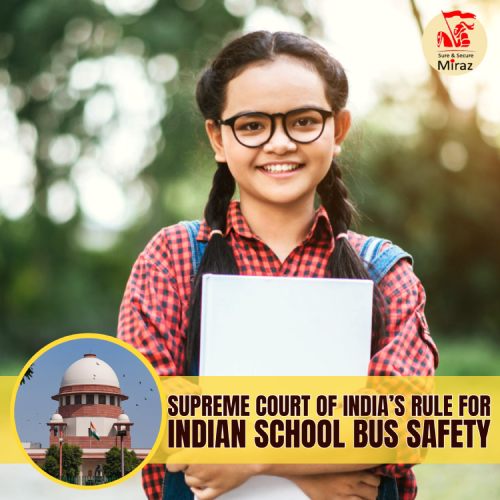The safety of children is an unwavering priority for any society. In a populous country like India, the lives of school-going children become even more crucial. With school buses being the primary mode of transport for millions of students navigating busy streets and unpredictable traffic, there is an urgent need for strict safety measures. The increasing number of accidents involving school buses has underscored the vulnerability of children, causing concerns about their physical and emotional well-being. Promoting school bus safety is crucial for protecting young lives, reassuring parents, and creating a conducive learning environment.
Recognizing the gravity of the issue, the Supreme Court of India has issued guidelines that serve as a comprehensive framework for enhancing school bus safety. Miraz Securitas, the leading security services company for private and international schools in Delhi, Gurgaon, and NOIDA sheds light on the guidelines issued by the apex Court for the Indian school buses.
1. Outside the bus:
School buses shall bear a yellow hue, with ‘school bus’ prominently inscribed on each side. ‘On school duty’ shall adorn the front and back, while driver, owner, transport helpline, and registration details must be displayed conspicuously for passenger and public access during emergencies.
2. Inside the bus:
- The bus must be equipped with a well-stocked first-aid kit.
- Horizontal grilles should be installed on the windows to prevent children from leaning out.
- Windows must offer a clear view inside the bus and should not be obstructed by curtains, sun films, or similar materials.
- Two emergency exit doors must be present for swift evacuation.
- The bus should have a functional Global Positioning System (GPS) and onboard CCTV cameras.
- Apart from the driver, there should be a conductor to assist children while boarding and disembarking, as well as a school attendant.
- Sufficient space must be available inside the bus to store school bags.
- Reliable locking mechanisms should be installed on the bus doors.
- A fire extinguisher should be readily accessible on the bus. The staff should be trained to operate these extinguishers.
- A tamper-proof speed governor should be installed to ensure the driver adheres to speed limits, with the provision for any parent or guardian to travel along for safety assurance.
3. School bus Staff
- Each school must assign a transport manager responsible for student safety, with their contact information clearly displayed inside and outside the bus.
- Drivers and attendants must undergo rigorous training programs to develop the necessary skills and knowledge to handle emergency situations, practice defensive driving techniques, and ensure the overall safety of students.
- The driver must possess a valid driving license and have at least 5 years of experience operating heavy vehicles.
- Comprehensive background checks must be conducted for all personnel involved in transporting students.
- No unauthorized person should be allowed to board the bus.
- Drivers should not use mobile phones while driving and must limit their interactions with the students and other bus staff.
- Drivers must follow the dress code for proper identification.
- Schools must conduct a medical checkup for their drivers every year.
4. Necessary permits
- School buses must obtain a permit from the relevant authority under The Motor Vehicles Act to ply on the road.
- The school bus should be registered in the name of the school, not the Trust or Society conducting the school.
- School buses must undergo annual fitness tests for permit renewal.
- A driver who has violated traffic laws even once cannot be employed by the school.
5. What should parents do?
Parents must also ensure that their children travel safely on school buses. The school authorities must be promptly notified of any negligence by the driver.
In the pursuit of an ideal educational ecosystem, it is imperative that we place the safety of our children at the forefront. A nation that values the well-being of its future generation will undoubtedly prosper.
- Home Security Tips If You Are a Single Mom - July 26, 2024
- What Can Security Do To Protect A Mine Site? - July 17, 2024
- What a Security Guard can do for an Oil and Gas Plant Unit? - July 12, 2024

